

Abnormal Auditory Gain in Hyperacusis: Investigation with a Computational Model. A European Perspective on Auditory Processing Disorder-Current Knowledge and Future Research Focus. Introduction Hearing loss (HL), i.e., reduced pure tone sensitivity affects over 5% of the world’s population (1) and is the fifth leading cause of Years Lived with Disability, a component of the Disability-Adjusted Life Year, used to measure the global burden of disease (2).
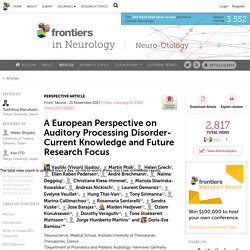
This hearing impairment, however, does not include the children and adult individuals who have normal hearing sensitivity but who experience auditory processing difficulties in everyday life that are reflected in reduced performance in other audiometric tests such as speech in noise or complex non-speech sound perception (3). This disorder is defined as “Auditory Processing Disorder” (APD) or “Central Auditory Processing Disorder” (CAPD) and is currently classified in ICD-10 as H93.25 for both acquired and congenital forms. The objective of the present paper is to define a baseline European APD consensus by experienced clinicians and researchers in this specific field of human auditory science.
APD Definition 2. 5. An Evidence-Based Perspective on “Misconceptions” Regarding Pediatric Auditory Processing Disorder. Audiometric Characteristics of Hyperacusis Patients. Central Gain Control in Tinnitus and Hyperacusis. Introduction Sensorineural hearing loss due to noise-exposure, aging, ototoxic drugs, or ear diseases that damage the sensory hair cells and/or auditory neurons in the cochlea is a significant sensory deficit that dramatically and negatively affects an individual’s quality of life and social interactions (1).

Hearing loss often gives rise to subjective tinnitus, a phantom ringing, buzzing, or hissing sensation that occurs in the absence of an external sound, and hyperacusis, an auditory hypersensitivity disorder in which low- to moderate-intensity sounds are perceived as intolerably loud or even painful (2–4). Approximately 50 million Americans report experiencing tinnitus, 16 million of which report the experience as persistent (5). Common Misconceptions Regarding Pediatric Auditory Processing Disorder. Hearing acuity may be difficult to assess in children and does not always reflect how a child “hears” in everyday life.
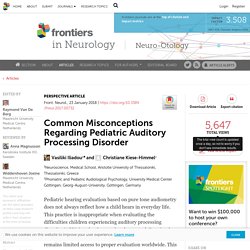
The audiological test battery must be built around the pure tone audiogram and may include tympanometry, stapedial reflexes, auditory brainstem responses, and otoacoustic emissions. However, relying on such a test battery to measure auditory function in the setting of school or playground in children referred for auditory processing deficits is incomplete (1). Auditory processing test batteries should be employed in these cases to more fully evaluate hearing in an ecological manner and fully examine how well the child hears outside the ideal conditions of the audiology lab.
Auditory processing evaluation is known to tap into the physiological function and integrity of the Central Auditory Nervous System (CANS) providing more comprehensive information about the integrity of the entire auditory system and the functional hearing status of a child. Author Contributions. Heterogeneity in Reported Outcome Measures after Surgery in Superior Canal Dehiscence Syndrome—A Systematic Literature Review. Introduction Rationale Reason for Conducting This Research Superior canal dehiscence syndrome (SCDS) is a rare condition in which a hole in the superior semicircular canal causes sound and pressure waves to evoke vestibular and auditory symptoms.
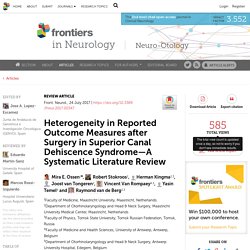
Symptoms can include sound- or pressure-induced vertigo (Tullio phenomenon), autophony, pulsatile tinnitus, bone conduction (BC) hyperacusis, conductive hearing loss, and “brain fog” (2–5). This broad variety of symptoms can make it difficult to distinguish SCDS from other neurological and otological pathologies. The ideal treatment should combine the safest approach with the most effective and durable closure technique.
Objective Methods Protocol To structure this systematic review, the PRISMA statement for reporting systematic reviews was applied. Eligibility Criteria Inclusion Criteria Exclusion Criteria Information Sources. Musical Sophistication and the Effect of Complexity on Auditory Discrimination in Finnish Speakers. Introduction Native language has been shown to influence auditory processing.

Mandarin speakers, whose language has lexical tones, show more precise pitch representation in the brainstem and enhanced pitch contour detection in the auditory cortex (Xu et al., 2006; Chandrasekaran et al., 2009; Bidelman et al., 2011). Music-Based Cognitive Remediation Therapy for Patients with Traumatic Brain Injury. Cognitive Psychology and Cognitive Neurosciences Laboratory, Department of Clinical Psychology, Neurobiology Research Center, National Institute of Mental Health and Neuro Sciences (NIMHANS), Bangalore, India Traumatic brain injury (TBI) is one of the common causes of disability in physical, psychological, and social domains of functioning leading to poor quality of life.
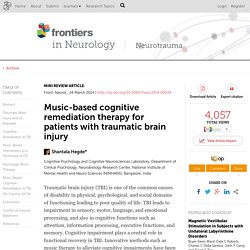
TBI leads to impairment in sensory, motor, language, and emotional processing, and also in cognitive functions such as attention, information processing, executive functions, and memory. Cognitive impairment plays a central role in functional recovery in TBI. Innovative methods such as music therapy to alleviate cognitive impairments have been investigated recently. The role of music in cognitive rehabilitation is evolving, based on newer findings emerging from the fields of neuromusicology and music cognition.
Citation: Hegde S (2014) Music-based cognitive remediation therapy for patients with traumatic brain injury. Neural Signature of DCD: A Critical Review of MRI Neuroimaging Studies. Introduction Developmental coordination disorder (DCD) is a highly prevalent neurodevelopmental disorder (1.8–6% of school-aged children), with an early age of onset and persistence into adulthood (1–3).
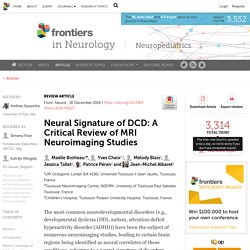
Although it is a heterogeneous disorder (4) with different phenotypes (5), it can be characterized by a persistent motor impairment that negatively affects daily living activities and/or academic achievement and cannot better be explained by intellectual disability or an underlying neurological condition (1). Posture, motor learning, and sensorimotor coordination are the main areas of functional difficulties experienced by children with DCD (6). The motor performances of children with DCD are slower, less accurate, and more variable than those of their peers. No single cause has been identified, and its etiology appears to be multifactorial (12, 13). Neural Correlates of DCD: From Early Hypotheses to the First Behavioral Studies Early Assumptions about the Brain Neuroimaging Studies. State Anxiety Subjective Imbalance and Handicap in Vestibular Schwannoma. Introduction Dizziness, a frequent symptom at a population level, has a reciprocal relationship with anxiety: dizziness can be a symptom of a generalized anxiety disorder, whereas, conversely, secondary anxiety can be a frequent feature of a recurrent or chronic vestibular disorder (1, 2).
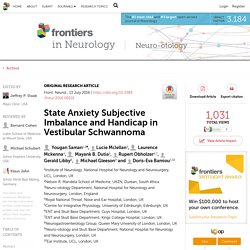
The 2008 National Health Service Interview of American households, completed by 20,950 out of 21,780 participants ≥18 years, found an annual prevalence of vestibular vertigo of 8.4%, with the presence of vestibular vertigo trebling the odds of anxiety, panic disorder, and depression (3). The core neuroanatomical site for this interaction is the parabrachial nucleus, i.e., the substrate for panic and anxiety disorders (4). Clinically, the mechanisms for the complex dizziness and anxiety interaction remain unclear (1, 6, 7).
Superior Canal Dehiscence Syndrome: Lessons from the First 20 Years. Introduction In 1998, Minor et al. described a series of patients with symptoms of chronic disequilibrium and sound- or pressure-induced vertigo and nystagmus in the plane of the superior semicircular canal (1).

Computed tomography (CT) imaging revealed a bony dehiscence over the superior semicircular canal in these patients, and a few underwent surgery to plug and resurface the superior semicircular canal, after which the primary symptoms improved. As additional patients were recognized, symptoms of bone conduction hyperacusis (i.e., hearing internal noises transmitted loudly to the affected ear) and pulsatile tinnitus became prominent features (2).
The name superior canal dehiscence syndrome (SCDS) was used to describe patients with these unique symptoms associated with the presence of a bony dehiscence over the superior semicircular canal. The syndrome has subsequently been modeled as a third mobile window in the labyrinth (3). Figure 1. Historical Context Figure 2. Etiology. Tinnitus What and Where: An Ecological Framework. Introduction Psychoacousticians and neurophysiologists have, as a rule, approached tinnitus by applying reductionist principles, meaning that the fundamental constituents of tinnitus have been studied in isolation from the overall experience.
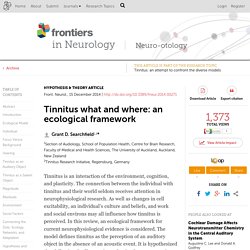
Traditionally psychoacoustic studies have attempted to control for cognitive effects rather than incorporating them as a requirement for real-world perception (3). Neurophysiological investigations of tinnitus have tended to look at specific loci (4, 5) or the cellular basis (6) of tinnitus generation. Although the complexity of tinnitus has been recognized in neurophysiological models for many years (7) it is now that tools have emerged to enable this intricacy to be examined (8). Unilateral Cochlear Implantation Reduces Tinnitus Loudness in Bimodal Hearing: A Prospective Study. Introduction This prospective study addresses changes in subjective tinnitus following cochlear implantation.
A new aspect is the investigation of bimodal implantees, who hear with the help of a cochlear implant (CI) on one ear and an acoustic hearing aid (HA) on the contralateral ear.